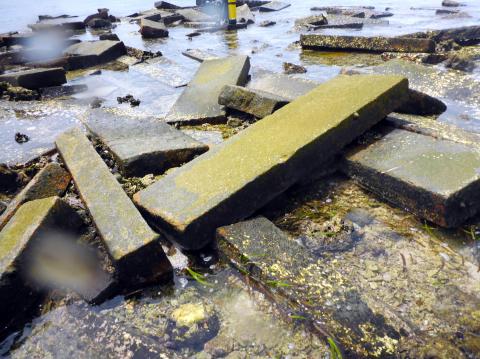Stone slabs found near the Pratas Islands (Dongsha Islands, 東沙群島) might be from a ship from the early Ming Dynasty that sank while carrying them as cargo, and they look to be of significant archeological value, experts said.
Academia Sinica biodiversity research center member Cheng Ming-hsiu (鄭明修) said he discovered the wreckage while researching coral biodiversity in the South China Sea last month.
Cheng said the hull of the ship had mostly rotted away and he at first assumed that the stone materials were part of the ship, adding that he used the site as a waypoint to anchor and undertake research dives.

Photo: courtesy of Cheng Ming-hsiu
Driven by curiosity, the research team visited the site at low tide and discovered that what they had thought for the past decade were remnants of the ship are actually carefully cut stone slabs and columns, Cheng said.
Some of the stone slabs are more than 1.8 meters long, Cheng said, adding that the exquisite work — evenly cut with mortise joints chiseled into the sides — suggests that they might have been intended for the construction of a palace or temple.
Cheng surmised that because of the lack of metal found at the site, the ship might have been damaged by typhoons or the northeasterly monsoon winds and drifted to the northern side of the Pratas Islands.
Cheng said he had also seen a boiler in a shipwreck on the west side of the Pratas Islands approximately 6m underwater, adding that he did not know how much material has been removed by foreign ships and divers.
The nation needs to devote more funding to underwater archeology, especially as Taiwan is an island, Cheng said.
Academia Sinica underwater expert Tsang Cheng-hwa (臧振華) said that to his knowledge, there are at least four shipwreck sites to the east of the Pratas Islands, although it was the first time he had heard of the stone materials Cheng found.
It might belong to ships from the Ming or Qing dynasties that were transporting the stone materials to Southeast Asia, Tsang said.
A draft act on the conservation of underwater cultural assets was recently reviewed by the Executive Yuan, Tsang said, adding that if the draft act passes its third reading in the Legislative Yuan it would be the nation’s first law protecting culturally significant material found underwater.
While some people might confuse underwater archeology with treasure hunting, according to the UNESCO Convention on the Protection of the Underwater Cultural Heritage, underwater cultural heritages are defined as “all traces of human existence having a cultural, historical or archeological character which have been partially or totally under water, periodically or continuously, for at least 100 years.”
The definition of underwater cultural heritages does not, however, include underwater cables or other devices currently in use and on the ocean floor.
The convention was adopted in 2001, but has only come into effect as of 2009.

Chinese Nationalist Party (KMT) Chairman Eric Chu (朱立倫), spokeswoman Yang Chih-yu (楊智伃) and Legislator Hsieh Lung-chieh (謝龍介) would be summoned by police for questioning for leading an illegal assembly on Thursday evening last week, Minister of the Interior Liu Shyh-fang (劉世芳) said today. The three KMT officials led an assembly outside the Taipei City Prosecutors’ Office, a restricted area where public assembly is not allowed, protesting the questioning of several KMT staff and searches of KMT headquarters and offices in a recall petition forgery case. Chu, Yang and Hsieh are all suspected of contravening the Assembly and Parade Act (集會遊行法) by holding

PRAISE: Japanese visitor Takashi Kubota said the Taiwanese temple architecture images showcased in the AI Art Gallery were the most impressive displays he saw Taiwan does not have an official pavilion at the World Expo in Osaka, Japan, because of its diplomatic predicament, but the government-backed Tech World pavilion is drawing interest with its unique recreations of works by Taiwanese artists. The pavilion features an artificial intelligence (AI)-based art gallery showcasing works of famous Taiwanese artists from the Japanese colonial period using innovative technologies. Among its main simulated displays are Eastern gouache paintings by Chen Chin (陳進), Lin Yu-shan (林玉山) and Kuo Hsueh-hu (郭雪湖), who were the three young Taiwanese painters selected for the East Asian Painting exhibition in 1927. Gouache is a water-based

Taiwan would welcome the return of Honduras as a diplomatic ally if its next president decides to make such a move, Minister of Foreign Affairs Lin Chia-lung (林佳龍) said yesterday. “Of course, we would welcome Honduras if they want to restore diplomatic ties with Taiwan after their elections,” Lin said at a meeting of the legislature’s Foreign Affairs and National Defense Committee, when asked to comment on statements made by two of the three Honduran presidential candidates during the presidential campaign in the Central American country. Taiwan is paying close attention to the region as a whole in the wake of a

OFF-TARGET: More than 30,000 participants were expected to take part in the Games next month, but only 6,550 foreign and 19,400 Taiwanese athletes have registered Taipei city councilors yesterday blasted the organizers of next month’s World Masters Games over sudden timetable and venue changes, which they said have caused thousands of participants to back out of the international sporting event, among other organizational issues. They also cited visa delays and political interference by China as reasons many foreign athletes are requesting refunds for the event, to be held from May 17 to 30. Jointly organized by the Taipei and New Taipei City governments, the games have been rocked by numerous controversies since preparations began in 2020. Taipei City Councilor Lin Yen-feng (林延鳳) said yesterday that new measures by